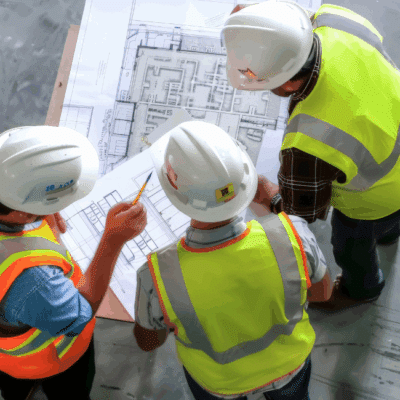Choosing the right Level of Development (LOD) for 3D models in complex projects such as data centers or central plants ensures project success. However, how much detail is enough to achieve accurate coordination and effective prefabrication? The levels of development have an impact on technical accuracy, efficiency, and team collaboration. For instance, LOD 300 is often sufficient for design stages and early coordination, as it resolves major clashes and ensures precise dimensions. Yet, more complex projects involving several systems, supports, hangers and 3D prefabrication demand greater precision, making LOD 350 and LOD 400 the ideal choices.
This article explores how to determine the appropriate LOD for 3D models in complex projects. It will also focus on stakeholder alignment, evaluating project complexity, and leveraging cost-saving strategies. With the right approach, teams can streamline workflows, reduce costs, and achieve optimal results. Let’s dive into the details!

What is the Level of Development (LOD) in 3D Modeling?
The Levels of Development (LOD) define the model’s geometric precision, information reliability, and applicability at various project stages. Each level builds on the one before, ensuring the model evolves to meet project and stakeholder needs. Here’s a quick recap of the key levels:
- LOD 100 (Conceptual Design): It represents basic geometric shapes for planning and massing studies. It also focuses on approximate size and location without detailed specifications.
- LOD 200 (Design Development): It adds general system layouts and spatial coordination with approximate dimensions, though connections and geometry remain undefined.
- LOD 300 (Construction Documentation): It provides accurate dimensions, geometry, and locations for BIM coordination and clash resolution, making it suitable for construction planning.
- LOD 350 (Detailed Coordination): It includes connection details, clearances, hangers, and brackets for precise constructability and coordination assessments.
- LOD 400 (Fabrication): It offers fully detailed, fabrication-ready models with precise manufacturer-specific data and assembly details. These models support 3D prefabrication and efficient installation.
- LOD 500 (As-Built): It reflects the final installed condition, integrating detailed geometry and asset data for operations and maintenance.
Ultimately, each LOD serves a distinct purpose by aligning geometric precision and information reliability with project requirements. Consequently, it enables teams to tailor LOD modeling strategies to effectively meet specific demands.
Aligning LOD Selection with Stakeholder Needs
Aligning with stakeholder requirements early on is essential for choosing the right LOD for 3D models in complex projects. A well-structured BIM Execution Plan (BEP) is pivotal in this process. Therefore, this document acts as a roadmap, specifying the required level of development for each project phase.
Additionally, engaging key stakeholders early ensures the model addresses specific needs. These stakeholders include engineers, contractors, fabricators, and facility managers. For example, contractors prioritize LOD 300 for an early effective clash resolution and construction planning. For a more detailed and “as-real” conditions coordination, a LOD 350 will be the most suitable one. On the other hand, fabricators may require LOD 400 for detailed, fabrication-ready drawings of conduits, panels, and equipment. Meanwhile, facility managers rely on LOD 500 for as-built models integrating asset data for long-term maintenance.
By documenting these expectations in the BEP, teams can avoid the pitfalls of over-modeling or under-modeling. This alignment ensures the model delivers value at every stage, fostering collaboration and minimizing rework. In short, LOD 350 and LOD 400 remain the gold standards for precise coordination and efficient prefabrication for complex projects.
Common Challenges in Defining LOD for Complex Projects
The complexity of the space significantly influences the required LOD for 3D models in complex projects. Moreover, in highly complex environments—characterized by dense equipment layouts, overlapping systems, and tight spatial constraints—LOD 350 and LOD 400 become indispensable. This level of development provides:
- Accurate clash detection to resolve potential conflicts before construction.
- Seamless coordination across multiple disciplines, minimizing misalignments.
- In the case of LOD 400, fabrication-ready precision for conduits, panels, and components, enables streamlined 3D prefabrication and installation.
In contrast, simpler designs with minimal system overlaps may not require the added effort of modeling beyond LOD 300, which often provides sufficient detail for basic construction coordination.

Maximizing ROI and Budgeting for LOD in Complex BIM Projects
Balancing the budget with the need for higher returns on investments (ROI) requires careful planning. Consequently, enhancing BIM coordination, reducing rework, and improving project efficiency with both LOD 350 and LOD 400 is essential. However, selecting the appropriate level depends on the specific needs of the project and its budget constraints.
Comparing LOD 350 and LOD 400
- LOD 350 (Detailed Coordination): Ideal for projects requiring detailed constructability assessments, this level includes connection details, clearances, and hangers to ensure smooth planning and reduce clashes during construction.
- LOD 400 (Fabrication): Essential for prefabrication-heavy projects, LOD 400 provides fabrication-ready models with manufacturer-specific details that streamline on-site assembly, cut labor costs, and minimize installation time.
Shared Benefits
Both levels offer:
- Enhanced Coordination: Detailed modeling improves interdisciplinary collaboration, reduces errors, and ensures smoother workflows.
- Cost Savings: Early clash detection and precise modeling mitigate costly on-site corrections.
- Improved Efficiency: Reliable models support faster decision-making and streamlined prefabrication and installation processes.
Strategic Budgeting for Precision
Balancing the budget with the need for higher LOD requires a phased and focused approach:
- Phased Modeling: Start with LOD 300 for initial coordination and progressively refine to LOD 350 or LOD 400 as the project advances, ensuring efficient resource allocation.
- Prefabrication Efficiencies: Use LOD 400 to support precise manufacturing processes, reducing on-site labor and adjustments.
- Prioritize Key Elements: Focus on critical systems and components directly impacting construction and prefabrication outcomes.
By carefully selecting the appropriate LOD for each phase, teams can balance precision with cost, avoiding unnecessary over-modeling while maximizing project value. At ENG, we guide clients in applying these strategies to maximize value while staying within budget constraints.
Key Takeaways on LOD for BIM Precision
In summary, determining the appropriate LOD for 3D models in complex projects requires a strategic approach. As it balances stakeholder alignment, project complexity, and budget considerations. For simpler designs, LOD 300 often suffices. However, for complex projects involving 3D prefabrication, the precision of LOD 350 and LOD 400 is essential.
As a result, key steps include engaging stakeholders, evaluating space constraints, and implementing cost-saving strategies like phased modeling. These actions allow teams to enhance BIM coordination, reduce errors, and streamline construction processes. At ENG, the right level of development transforms 3D models into powerful tools for project success.
Ready to take your project to the next level? Partner with ENG and define your LOD requirements today to unlock efficiency and precision in your models.




